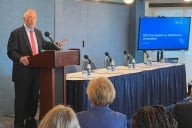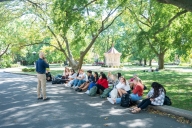You have /5 articles left.
Sign up for a free account or log in.
A group of students settle into their seats for the first day, unsure what to expect from their first visual arts course.
"I happen to know that pretty much everybody in this class has no creativity … zilch," the Rev. Jim Mayzik, the instructor at Fairfield University, tells the students. Father Mayzik can sense that he has agitated the students, but none of them utters a word. Better lay it on thicker.
“It’s not your fault, though, it’s your parents’ fault. They don’t have a creative bone in their bodies. They ruined you,” he tells them. The students may have accepted hearing themselves degraded, but they won’t bite their tongues when it comes to defending their families. “That’s when the personal attacks start,” says Father Mayzik. A little thicker still. "I know you have no creativity, because you came to Fairfield, to this kind of place."
"Then we have a huge argument," Father Mayzik says. “Eventually I tell them I was lying. I want to show them that they really have been conditioned, since they were little, to have their creativity taken away from them.” To get that creativity back, Father Mayzik starts at the start. He gives students construction paper and glue. “They love that,” he says. “Give college kids Play-doh, and the stuff they come up with is great."
Give them digital animation equipment, and the stuff they come up with is even better. So Father Mayzik decided to found a new major at the Roman Catholic institution in Fairfield, Conn.: New Media: Film, Television and Radio. It is the first media program led by Jesuit priests.
Though religion is sometimes viewed as oppressive of free artistic expression, Father Mayzik, a filmmaker with an MFA from New York University’s Tisch School of the Arts, hopes to show that “it is possible both to believe, and to be able to think,” he said. That, to him, is what being Jesuit is all about. Like St. Ignatius, he wants to be among students, encouraging self-exploration, rather than holed up in a church. He prefers the editing suite to the pulpit, and wants a program that always pushes students to address deep life questions. “The creative moment is where I see the divine intersecting with the human most powerfully,” he says.
Father Mayzik started a new media minor seven years ago, and it quickly grew in popularity, drawing about 90 students this academic year. To get the major rolling, all he had to do was round up two more Jesuit priests with media experience who would be willing to relocate to Connecticut. Father Mayzik figured there were all of about 10 to 20 Jesuits as directly involved with film as he is -- in the entire country. No sweat.
The Rev. Mark McGregor was finishing his MFA at Loyola Marymount University, in California. Father McGregor, a screenwriter, met a student at Loyola who had gone through Fairfield’s new media minor, and was impressed with what the student had to say, and the prospect of working with other Jesuits.
“Jesuits have roots in the arts, from the 16th and 17th centuries, a tradition of giving people the skills to tell a story,” Father McGregor says.
He became interested in telling human stories as he drove from Panama to the United States in 1976. “I saw the dark side of life, but also a lot of hope in places people might not expect it,” he says. So Father McGregor crossed the country to visit Fairfield, hoping the program would encourage his kind of storytelling. “I definitely gave him a hard sell,” says Father Mayzik. And he liked what he saw. One down, one to go.
The Rev. Mark Scalese has an MFA in film making from Temple University, and worked in a television production house in Washington, D.C., for four years. He wanted to teach people to be thoughtful, ethical practitioners of media skills. And, like the others, he wanted to tell human stories. "Our motto is ‘For the greater glory of God,' " Father Scalese says. “If we can show what’s inherently beautiful about being human, that does give glory to God.” Father Scalese was the only Jesuit at his production house. It didn’t take the hard sell.
When the three tell people that they wanted to work with other Jesuits, "they say, ‘Oh, so you make religious films,' " Father Mayzik said. “No I don’t,” he replies. “I’m not even in a church much.” Rather, he wanted a program that bridged the communications and fine arts departments at Fairfield, and allowed students to attack philosophical, spiritual, and social questions artistically. "What’s the point of this? Where am I now, and where am I going?," Father Mayzik asks, outlining the questions that drive him to make films, and which initially drew him to the Jesuits he met as an undergraduate at Georgetown. “I happen to think the creative moment is one of the best ways to get in touch with these questions.”
'To Believe and to Think'
Before he came to Fairfield, students had to choose between communications and fine arts classes, and never the twain did meet. Through the new media major, Father Mayzik hopes to teach skills from screen writing to digital animation to convey one of the most important things he himself has learned from fellow Jesuits: “to be able to believe and to think, the two are not antithetical.”
The creative nexus Father Mayzik hopes to draw students into resides in Fairfield’s state-of-the-art Media Center. The center is festooned with works-in-progress: story boards, books, cameras and microphones litter the halls, the television and sound studios, and the digital editing suites. Fifteen staff members, along with about a half-dozen adjuncts, populate the center, each a writer, editor, director or audio specialist. Some of the staff members produce videos for the university, and students pop in and out to peek over their shoulders.
“The whole building is set up to so you’re challenged to do creative things,” says Father Mayzik. And he just created a new position at the center, “external projects producer,” which will be an outside artist who works with Fairfield students on productions. Where priests of the past have raised spires visible for miles around, Mayzik plans to buy a production truck with an extendable satellite uplink, “to get things out there to the greater world.” Still, he wants to keep the program small, so he knows every student, and can bask in their creative moments. Like that time a student found Jesus … Kung Fu Jesus.
The animated short uses characters Mayzik describes as looking " 'South Park'-ish.” A group of kids are playing hide and seek. At the end of the game, the seeker realizes one person is missing, but can’t remember who. Soon, the kid finds the missing person: an anime style Kung Fu Jesus. With the game over, one kid’s mother brings out water. “Oh no, water! Mom, come on!” Father Mayzik recalls the cartoon kids crying. Naturally, Kung Fu Jesus turns the water into Kool-Aid, and everybody lives happily ever after.
The cartoon ended up playing on TBS. The creator, Pat Tobin, who also made an animated video that was shown on MTV2, graduated with a minor in new media in 2003, went back to work at the Media Center for a year, and now plans on a career in screen writing. “It wasn’t NYU film school, but there’s a lot of high end equipment, and I never felt like I couldn’t do what I wanted to do,” Tobin said. “I had a very successful four years there creatively. I can only imagine what will happen with the new major.”
Things are happening already. Anticipating that the major would be approved partway through the academic year, several students were able to graduate as Fairfield’s first new media majors. A local businessman who rescued an old, local theater let the students use it to screen their films at the end of the year. “It gave our kids a chance to have their work literally shown on the big screen,” says Father Scalese, who now expects the “Cine Film Festival” to grow.
For Father Scalese, the Jesuit approach to new media simply means that projects have an introspective bent. He often asks students to use posters and television to answer three questions: “Who am I?,” “Whose am I?,” and “Who am I called to be?” If the program is successful, some students might end up addressing still deeper questions. After all, what would Kung Fu Jesus do?








